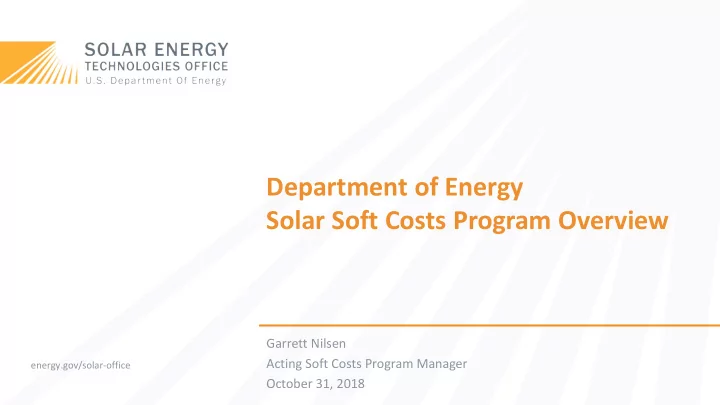

Department of Energy Solar Soft Costs Program Overview Garrett Nilsen Acting Soft Costs Program Manager energy.gov/solar-office October 31, 2018 energy.gov/solar-office
Solar Energy Technologies Office Overview WH WHAT WE WE DO: SETO works to make it faster , easier , and more affordable for Americans to access solar power by making smart R&D investments to lower costs so solar electricity is fully market-competitive without subsidies. HOW WE W WE DO IT: SETO drives down the cost of solar through cooperative research, development, demonstration, and deployment projects with private companies, universities, state and local governments, nonprofits, and national laboratories. SETO funds research through its five subprograms: Photovoltaics, Concentrating Solar Power, Systems Integration, Soft Costs, and Technology to Market. FUTURE URE: IMPA PACT: SETO has funded work to drive down the In addition to game-changing, cost-lowering R&D, cost of solar 90% toward the 2020 cost SETO will continue to spur solar development and target, supporting the 250,000 JOBS in increase grid resiliency across the country to diversify the U.S. domestic energy supply . the solar industry. *NREL Site-Wide Facility Support 2 energy.gov/solar-office
Solar Technologies: Photovoltaics, Concentrating Solar Power Photovoltaic (PV) technologies absorb energy from sunlight and convert it directly into electricity through a semiconductor material, such as silicon. Individual PV panels/modules are connected together to make large arrays. Concentrating solar power (CSP) technologies use mirrors to reflect and concentrate sunlight onto a receiver where it is collected and converted into heat. This heat energy can be stored and used to produce electricity whenever it 4 is needed. energy.gov/solar-office
Modern Electric Grid: Two Way Energy and Data Flow Goal: Centralized and distributed generation optimized with finely tuned, 2-way load balancing 5 energy.gov/solar-office
Soft Costs are Declining (Just not as rapidly as Module Costs) Setting and meeting ambitious goals Non-Module Costs $8.00 Between 2008 & 2016 40 % $6.00 $4.00 $2.00 $0.00 Decrease in Non-Module Costs 1998 2000 2002 2004 2006 2008 2010 2012 2014 2016 Implied Non-Module Cost is used as a proxy for soft costs due to data limitations Source: NREL 6 energy.gov/solar-office
Balance of Systems (Soft Costs) 7 energy.gov/solar-office
Core Components of Soft Costs Program FOUNDATIONAL RESEARCH, DATA, AND ANALYSIS LOWER SOFT INSTITUTIONAL SUPPORT COSTS & BARRIERS TRAINING 8 energy.gov/solar-office
Breakdown of Funding by Core Component Training Foundational 20% Research, Data, and Analysis 38% Institution al Support 42% energy.gov/solar-office
Workforce Training Solar Training and Education for Professionals (STEP) GEARED: Power Systems Engineering NEW PROGRAMMING IN 2018/19!! energy.gov/solar-office
Foundational Research, Data, and Analysis energy.gov/solar-office
Institutional Support • Addressed through: Stakeholders Nationwide!! • Designation Programs • Challenges • State Energy Strategies • Solar Market Pathways energy.gov/solar-office
Solar Market Pathways The Solar Market Pathways Program brings together 14 diverse teams under a single goal: SHARE BEST PRACTICES TO REDUCE SOLAR’S SOFT COSTS. energy.gov/solar-office
Solar in Your Community Challenge Team Map 172 Teams from 122 Cities and 4 American Indian Reservations in 40 States plus Puerto Rico, Guam and Washington D.C. 14 energy.gov/solar-office
SolSmart – Nationally Distinguished. Locally Powered. Who’s near by? MD – 2 Laurel-Silver Carroll County- Silver DC – 1 Washington- Gold VA – 8 Alexandria- Bronze Fairfax- Bronze Falls Church- Silver Arlington- Bonze Richmond- Silver Charlottesville- Silver Abelmarle- Bronze Roanoke- Bronze 15 energy.gov/solar-office
Solar Energy Innovation Network Cohort B: Improving Grid Flexibility and Cohort A: Improving Reliability and Resiliency through Advanced Siting and Affordability of Solar Energy through Operations of Solar + DER Options Analysis and Systems Design Note: PJM territory is highlighted as one location. energy.gov/solar-office
What’s New? Beginning in 2018/19: • 7 Workforce Projects ($12.7M) • Covering: Digital Skills of Power Systems, Veterans in the Solar Workforce, Workforce Capacity Building • 4 Low and Moderate Income Projects ($4.7M) • Covering: New Capital Structures, LMI in Puerto Rico, New Risk Evaluation Methods • 15 Lab Analysis Projects ($15M) • Covering: Cost Benchmarking, PV O&M, Agriculture Issues, Valuation, Data Access, Business Practices and more energy.gov/solar-office
Thank you for your time. Questions? Garrett Nilsen Garrett.Nilsen@ee.doe.gov energy.gov/solar-office energy.gov/solar-office
Recommend
More recommend